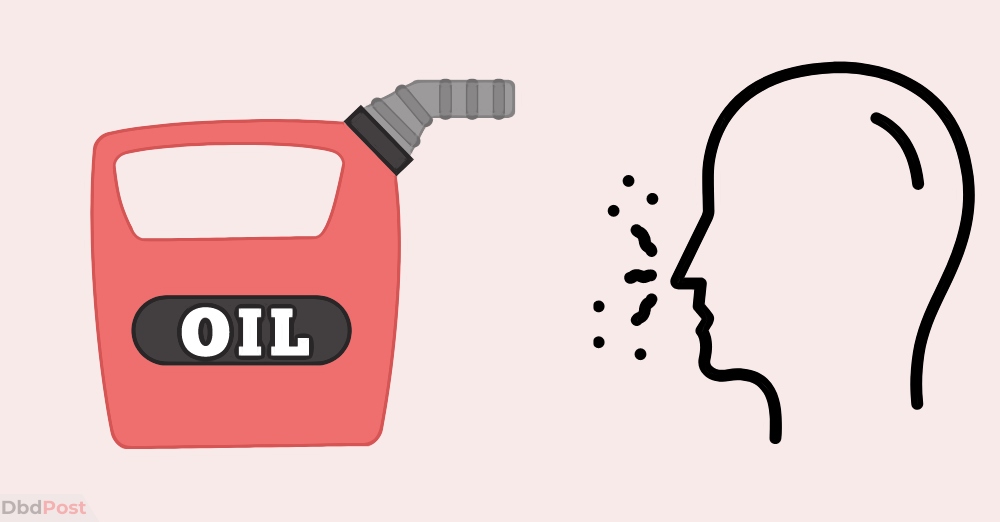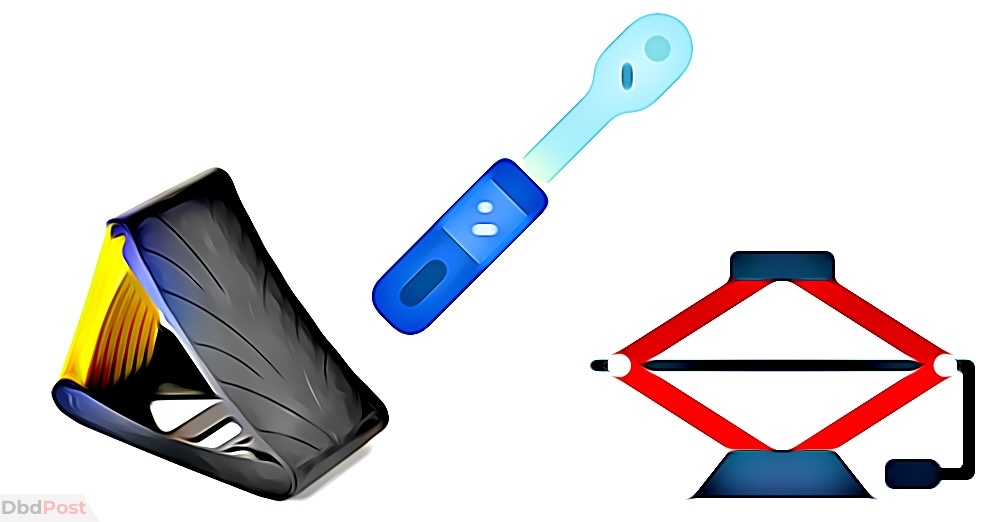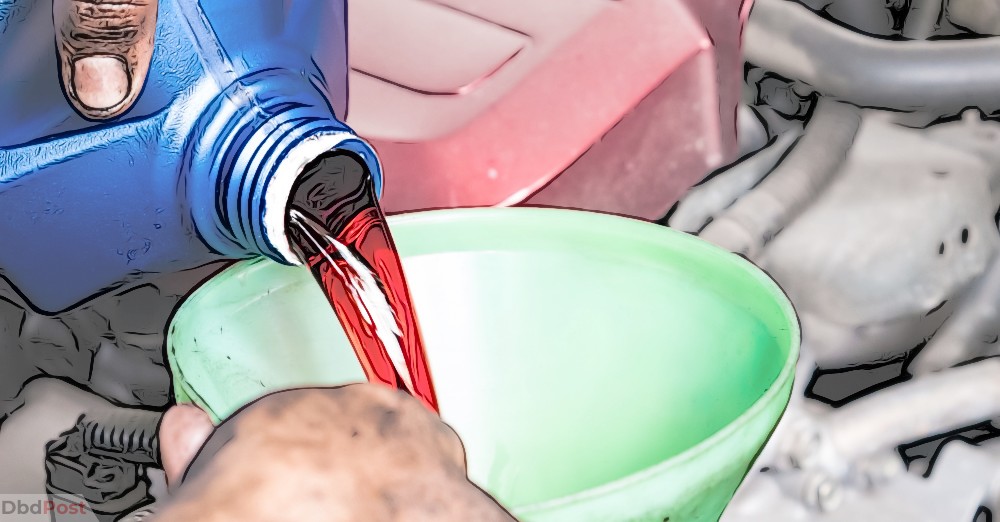Do you know how to check transmission fluid of your vehicle? If not, you are not alone.
Many people are unaware of how to check their transmission fluid which may result in expensive repairs.
Transmission fluid is an essential component of your vehicle’s operation. It is critical to know if you need more or if your transmission fluids need to be changed.
The only way to really understand the condition of your transmission fluid is by checking the color and smell of the fluid. If you are not sure how to do this yourself, follow our guide on how to check transmission fluid level in a few simple steps!
We have put together a step-by-step guide to help you learn how to check transmission fluid levels and colors in just five minutes! Follow these easy instructions, and keep your vehicle running like new for many miles ahead.
Additionally, you will also learn what color is best for your vehicle and what smell indicates problems with your transmission. We also have tips on where to find the transmission dipstick and how often you should check transmission fluids for optimal performance of your car!
Before diving into the deep first, let’s understand few basics about transmission fluid.
What is the transmission fluid?

The transmission fluid is a special kind of oil that helps to keep running the transmission system. The primary function of transmission fluid is to create a lubricating surface for the gear sets, which reduces friction.
It is important for your vehicle because, without the proper amount of transmission fluid, your vehicle may not be able to get where it is going.
The transmission fluid is responsible for temperature regulation, cleaning the engine’s parts, and helping to make sure everything is running smoothly.
What does transmission fluid smell like?

Transmission fluid has a distinct smell. It is important to know how the transmission fluid smells when it is fresh and how it smells overtime when it is in bad condition.
When the transmission fluid is first added to your vehicle, it may have a slightly sweet smell or tart odor.
The smell of the transmission fluid will change over time. When the transmission is in poor condition, it will have a more metallic burned-like, and unpleasant odor.
Ultimately, you can identify a problem with the transmission by its smell.
What do different transmission fluid colors mean?

As the smell of transmission fluid changes, so does its color.
It’s an indication of how well your transmission is maintained and whether or not there are any problems.
Pay attention to what your vehicle’s color of transmission fluid is telling you!
In general, transmission fuel color can be found in five different variations:
- Red
- Light brown
- Brown
- Dark brown or black
- Pink
What does red transmission fluid mean?
When the transmission fluid is red, it is in good and healthy condition.
It also means that the transmission is not overheating and the internal parts are not corroding.
Usually, it is red when it is first filled.
What does light brown transmission fluid mean?
There are a couple of reasons if you see that your transmission fluid is light brown.
First, if the transmission fluid smells burnt out and it is light brown, there is more likely some internal damage to your vehicle’s transmission system.[1]https://autotrends.org/2021/05/27/transmission-fluid-color/
It is also possible that the transmission fluid is overheating, which might require a cooling system flush.
Sometimes, light brown transmission fluid can occasionally be caused by not fully flushing the oil or using the incorrect type of oil.
With your transmissions fluids having this color, it is best to diagnose problems immediately as these can lead to more significant issues like needing to repair the complete transmission system.
What does brown transmission fluid mean?
A brown transmission fluid color means that the condition of transmission is just about deteriorating.
It can be caused by regular wear and tear, time, mileage, or the transmission fluid being old.
The lubricating capacity of transmission fluid at this stage becomes low, and it can cause damage to the internal systems of your transmission.
When your transmissions fluid is brown, make the service appointment immediately. It is best to get them checked out at an automotive service station.
What does dark brown or black transmission fluid mean?
When transmission fluid is dark brown or black with a burnt smell, it means that there is major damage to the transmission.
It also means that the fluid is very old, not changed often enough, or your car’s engine has overheated.
It is possible that this fluid has water in it or burned out due to overusing the transmission system.
When your transmissions fluids have this color, it is best to have them checked immediately.
What does pink transmission fluid mean?
If your transmission fluid is pink, it is more likely that it is contaminated and not proper transmission fluid.
It is also possible that someone put brake fluid in the car instead of transmission fluid.
It could also mean that there is a water leak or coolant in the transmissions system.[2]https://autotrends.org/2021/05/27/transmission-fluid-color/
If you see pink transmission fluid, get your car checked at an automotive service station and change the transmission fluid completely.
Now you know what the different colors of transmissions fluids mean and what to do when you see them. Let’s start our main goal of learning how to check transmission fluid of your vehicle.
How to check transmission fluid?

There are two types of transmission systems in modern vehicles, automatic transmission systems and manual transmission systems.
Checking the automatic transmission fluid in an automatic transmission system is easy, and it only takes a little effort.
However, checking the fluid level in the manual transmission system needs more material and work since you must jack up your vehicle from the ground.
So for your convenience, we have divided this guide into two sections. At first, let’s discuss the steps to check the automatic transmission fluid.
How to check automatic transmission fluid?
To check automatic transmission fluid, follow these six steps:
1. Gather the following items:

To check automatic transmission fluid, you will need to gather the following items:
i) gloves
ii) rags
iii) white tissue
2. Park your vehicle on a leveled surface.

Park your vehicle on a leveled surface with the parking brake on, and the engine turned off. Before shutting off the engine, make sure it is warm.
Warning: For your safety, make sure the parking brake is on while you work on it.
3. Open the hood of your vehicle and locate the transmission fluid dipstick.

Do not confuse transmission fluid dipstick with engine oil dipstick. Check the owner’s manual if you are not sure to identify the transmission dipstick.
4. Take out the automatic transmission fluid dipstick.

Gently remove the transmission dipstick after locating it. It will usually come out easily if the engine is warm enough. If you can not pull it out, turn on the engine to warm up the transmission fluid, then try again.
5. Wipe the dipstick clean with a white tissue or rag.

After pulling out the dipstick, make sure to wipe it clean with a rag or white tissue to reinsert it.
6. Reinsert it and pull it out to check the color and level of the automatic transmission fluid.

Now you are finally checking the automatic transmission fluid.
i) Check level: To check the automatic transmission fluid level, look for a transmission fluid dipstick mark that indicates the transmission fluid level. Depending on the car’s model, level marking notations such as “Add,” “OK,” and “Max” may be found on dipsticks. If the fluid level is on Add mark, it means it is time to top up the transmission oil.
ii) Check color: Wipe the dipstick on a clean white tissue. If it is red, that means it’s in healthy condition. If it turns brown or very dark, then there may be a problem with the transmission fluid.
This completes the process of checking the automatic transmission fluid.
Tips: Where to find the transmission fluid dipstick?
The location of the automatic transmission fluid dipstick may vary depending on the model of the car.
You can locate it following these tips:
i) If your car has rear-wheel drive, you can find the automatic transmission fluid dipstick on the back of the engine compartment, usually behind the engine oil dipstick.[3]https://anewwayforward.org/how-to-check-transmission-fluid/
ii) If your car has front-wheel drive, look for the dipstick at the front of the engine compartment. It will most likely be sticking out at the transaxle.[4]https://anewwayforward.org/how-to-check-transmission-fluid/
How to check manual transmission fluid?
The procedure for checking manual transmission fluid differs from that of automatic transmission fluid.
Because most manual transmissions do not have a dipstick, you should check it from the fluid filler plug located under the vehicle.
To check manual transmission fluid, follow these six steps:
1. Gather the following items:

To check manual transmission fluid, you will need to gather the following items:
i) wheel chocks
ii) jack and jack stands
iii) torque wrench
2. Place wheel chocks on rare tires.

Place wheel chocks on the opposite sides of the car on rare tires. This is to ensure that the vehicle does not move when you are jacking up.
3. Position the jack and jack stand under the car.

Before positioning the jack, make sure you set the jack stand under the car. Once the jack is positioned under the car, raise it slowly, ensuring it is secure.
4. Locate the fluid filler plug.

The fluid filler plug is usually located underneath the car and might be on the side of the transmission case. It typically has a rubber cap. If you can not find the fluid fill plug, check the owner’s manual for more information on finding it.
5. Unscrew the filler plug.

Unscrew the filler plug with your hand while trying not to spill any fluids. Once it is unscrewed, wipe off the oil that spilled out.
6. Check the color and level of fluid.

Take a look at the manual transmission fluid after removing the filler plug with your hand.
i) Check level: Make sure fluid levels are between the bottom of the filler plug and its top. If fluid levels are low, you can add more at this stage.
ii) Check color: The fluid should be red. If it is brown or has some metal particles in it, then your vehicle’s manual transmission might need to be repaired.
Remember: After checking the manual transmission fluid level and color, screw the fluid fill plug back in.
This completes the process of checking manual transmission fluid. We hope at this point you know how to check transmission fluid by yourself.
Learn More: How Much Does it Cost to Wrap a Car
How to add transmission fluid?

If the transmission fluid is below the bottom mark, you need to add more. Here are some tips on how to do this:
1. Find out what kind of transmission fluids your vehicle requires.
Different cars have different requirements for transmission fluid. So, it is important to find out what kind of oil your car takes.
You can find this information from the car’s owner manual, asking mechanics, or by searching online.
2. Buy transmission fluid.
Once you know what kind of oil your car needs, go out and buy it.
3. Let the car cool down.
Never drain or add fluids to a hot car. It is important to let the engine cool down before you proceed.
4. Remove filler plug.
Once the car cools down, remove the fluid filler plug as described in Step 5 of “How to check the manual transmission fluid.”
5. Drain the transmission fluid.
Pour the transmission fluid into a drain pan or an old container that is intended for this purpose.
6. Clean and re-insert the filler plug.
If you spilled any fluids during draining, clean them up with a paper towel. Re-insert the filler plug back into its place and tighten it with your hands to ensure no leaks.
7. Adding fluid.
Pour the new transmission fluid using the funnel and add the required amount. You can find the information about how much oil does your car need from the owner’s manual.
8. Start the engine and check fluid levels.
Start the engine of a car and let it run for a few minutes so that the oil can circulate and fill up the transmission. Recheck the fluid levels and add more if necessary. If it is on the right level, this completes the process of adding transmission fluid.
Remember: Never overfill the transmission fluid. Overfilling can cause damage to the engine.
You should check it at least once a month. If you find that the automatic transmission fluid is leaking, you should see a mechanic immediately.
Remember: Having regular checkups for your vehicle’s transmission fluid can help you save money in the long run.
FAQs about checking transmission fluid
How often should you check transmission fluids?
It is better to check transmission fluids at least once a month to prevent any significant transmission system damage. If the transmission fluid is leaking, you should see a mechanic immediately.[5]www.drivingtips.org/transmissionfluid.html
Is transmission fluid oil?
Yes, transmission fluid is a kind of oil that is very thin. It fills up the transmission system of your car and keeps it running smoothly.
Why should you check your transmission fluid?
You should check your transmission fluid regularly to ensure that there are no leaks or damages. You can prevent significant damage by checking the transmission fluid and taking action if the levels are low.
Getting regular checkups for your car’s transmission can help you save money in the long run.
How to tell if the transmission fluid is low?
There are various symptoms that indicate that your car’s transmission fluid is low. One of the more obvious signs is burning smells from the engine. Other symptoms may be as follows:
– Overheating of transmissions.
– Slipping gears.
– Hard or delayed gear shifting.
– Clunky shifting between gears.
– Whining or whining noise during shifting.
– Grinding sounds from the transmission system.
– Car stalling while driving.
– Grinding gears while driving.
If you find any of these symptoms, you should take your car to a mechanic or auto technician before the situation escalates to more severe problems with your car’s transmission.
Where is the transmission on a car?
The transmission of the front-wheel car is usually located under the front hood. Whereas the transmission for a rear-wheel is behind the engine beneath the dashboard.
How often to change transmission fluid?
The manufacturer’s manual is your best reference for information on how often to change the fluid. In general, you should change your vehicle’s transmission fluid every 30,000 to 100,000 miles. It varies according to the manufacturer’s specifications and your driving habits.[6]www.drivingtips.org/transmissionfluid.html
If you drive more often in the city area, it is better to change the transmission fluid more frequently than those who drive on the highway.
If your vehicle is older than six years and has more than 100,000 miles on the odometer, it is recommended that you change it regularly.
You should also change your transmission fluid even if you do not drive the car often.
Unless your owner’s manual suggests otherwise, you should change it at least every 1 or 2 years.
This way, the condition of your fluid is always known, and there are no problems that arise because you did not replace it on time.
What happens if you do not change your transmission fluids?
If you do not replace or check your transmission fluid, your car’s performance will decrease. It may result in an acceleration problem, typically felt by the driver when they step on the gas pedal.
Gear will not go smoothly, and it will not operate as it should.
The vehicle may also produce a burning smell caused by the friction between certain parts of the transmission.
Do you check your transmission fluid levels when it is hot or cold?
It is recommended to check your transmission fluid when it’s warm but not hot or cold. By checking the transmission fluid while it’s warm, you can accurately read the levels.[7]www.drivingtips.org/transmissionfluid.html
If you overheat the engine, then the transmission system will also get overheated, which will give you the incorrect reading. Also, keep in mind that when you check transmission fluids level when the engine is cold, you will receive a false indication that it is low.
Do you check your transmission fluid level with the car running?
Yes, it is recommended that you inspect your transmission fluid with the car running and when the fluid temperature is warm, not too hot. By doing so, you can get a more accurate indication of the levels in the transmission fluid.[8]https://www.mvorganizing.org/do-you-check-cvt-transmission-fluid-with-the-car-running/#How_much_transmission_fluid_does_a_Ford_f250_need
As with the nature of all other fluids, transmission fluids also expands when it is hot and contract when it is cold. That’s why you should check the fluid level with the engine running, but not too hot or cold.
Where to get transmission fluid replacement?
You can buy transmission fluid from a local mechanic, an auto parts store, or a car dealership. You will need to provide the make and model of your vehicle to be matched correctly.
How much does a transmission fluid change cost?
The price of a transmission oil replacement varies from one shop to another. It can cost you between $80 and $300 depending on where you get it done and the make and model of your car. On average, it costs around $100 for a transmission oil replacement.
Don’t forget to check your owner’s manual for the recommended specifications of your vehicle’s transmission fluid.
How to know if the transmission fluid is contaminated?
Usually, when it gets contaminated, you will see the overheating of transmission. While shifting the gear, it is difficult for the transmission to pick up speed. Furthermore, the transmission shows excessive noise and vibration when going over a high speed.
Another way to find out either fluid is contaminated or not is by checking. When the fluid is contaminated, it will be thicker than usual and will feel oily.
How much transmission fluid do you need?
Depending upon the make and model of your vehicle, in general, your transmission requires 4 to 18 quarts of fluid. Please check your owner’s manual for the required specifications of your vehicle.
What kind of transmission fluid do you need?
You need to get your vehicle’s transmission fluid specifications from the owner’s manual for accurate information.
There are various kinds of transmission fluids. The most common transmission fluids are as follows:
i) Type F
Type F fluids were the most popular fluids used in the 80s series of cars. In modern vehicles these days, it is not recommended to use type F transmission fluid.
ii) Dexron and Mercon series
Dexron and Mercon are the common fluids used in today’s cars. Most of the Ford and GM vehicles use the Dexron or Mercon series of transmission fluid.
iii) HFM fluids
Highly Friction Modified fluids are used in vehicles that need reduced friction to operate their transmission system. Honda, Toyota, Hyundai, Chrysler, Jeep, Saturn, and several other manufacturers use this fluid under a variety of their name brands, HFM fluids.
iv) Synthetic fluids
Synthetic transmission fluid is the best type of ATF to use in today’s vehicles. It gives you more mileage, reduces heat buildup inside the transmission, and does not break down as quickly as conventional transmission fluid. So that’s why many top manufacturers have started to use fully synthetic transmission fluid.
Where does transmission fluid go?
Transmission fluid flows throughout the transmission system to lubricate, cool, clean, and conduct heat away from gear and other transmission parts.
The fluid also reduces the power needed to operate the transmission by keeping some moving parts or components cool.
Where is the transmission fluid location?
If you know where to find your dipstick, then it is where the transmission fluid is located.
In most rare-wheel drive vehicles, you can find it at the back of the engine compartment. For the front-wheel vehicle, it’s more likely to be found at the front of the engine compartment.
What do you do if you find that your transmission fluid is black, burned, or brown colored?
If you found that your transmission fluid is black, burned, or brown colored, it is recommended that you flush and replace the fluid as soon as possible.
You should also have your vehicle checked by a professional to determine the cause of the problem. Here is a list of possible causes:
– The vehicle was not driven as it should have been; for example, too much idling or the wrong gears were used for the driving conditions.
– The fluid has not been flushed and replaced regularly.
– It is possible that the wrong type of fluid was put in the transmission or that some other fluid-like as brake fluid, was used instead of transmission fluid.
– There was a problem with the transmission, which was not diagnosed.
What is a transmission fluid dipstick?
The term “dipstick” refers to a long, thin strip of material that can be inserted into a fluid to check the fluid level and its color.
What is ATF fluid?
ATF means automatic transmission fluid. This is the fluid that your vehicle transmission needs to change gears and ensure that other moving parts of your transmission system are kept cool.
It’s also the fluid that you check with your car’s dipstick to make sure it is filled to the right level.
What color should the ATF be?
The fluid should be red and without any odor. If it smells burnt or black, brown, or grayish, it is time to replace your fluid.
At the same time, if there are metallic particles on the dipstick, this is an indication that you also need to have your transmission overhauled.
Final thoughts
In this guide, we have talked about how to check transmission fluid on both automatic and manual transmission vehicles. As well, we have discussed why it is critical to know your transmission fluid’s condition.
We hope this guide will help you know your transmission fluids condition so you can prevent future problems with your vehicle.
Share these tips with your friends and family who may need them!
- 107shares
- Facebook Messenger
About the author
DbdPost Staff is a team of writers and editors working hard to ensure that all information on our site is as accurate, comprehensive, and trustworthy as possible. Our goal is always to create the most comprehensive resource directly from experts for our readers on any topic.

![How Much Does it Cost to Wrap a Car in [year]? how much does it cost to wrap a car-feature image](https://dbdpost.com/wp-content/uploads/2021/09/how-much-does-it-cost-to-wrap-a-car-feature-image-150x150.jpg)
![How to Delete Shein Account? ([year] Edition) feature image-how to delete shein account](https://dbdpost.com/wp-content/uploads/2021/10/feature-image-how-to-delete-shein-account-150x150.png)

